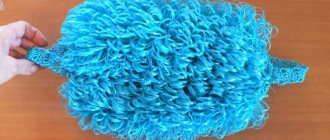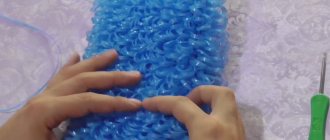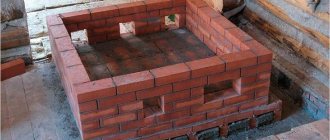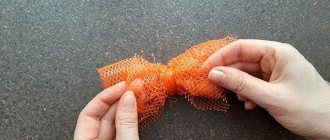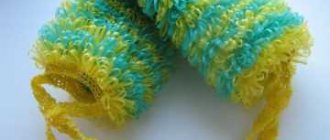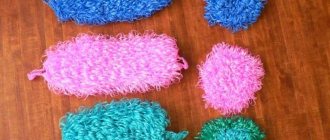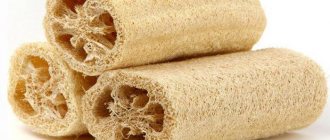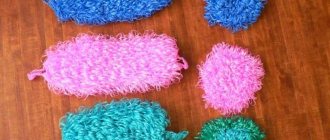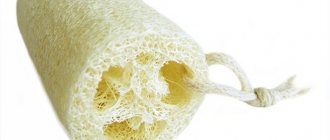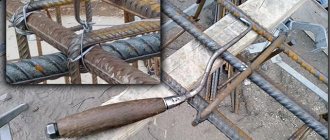A washcloth is an indispensable bath attribute. There are countless varieties, types and materials from which they are made. Any novice needlewoman can knit a toy washcloth for her child, or a bath washcloth made of natural material (sisal twine) for her own use. Each family member should have a separate washcloth and change it at least once every three months. Do-it-yourself knitting is a budget-friendly and practical solution. Crochet washcloths are made very quickly, and a creative approach will diversify their appearance and delight any child.
Crochet washcloths toys
Crochet flat washcloth
Crochet flat washcloth
The flat washcloth knits quickly, does not stretch out and lasts a long time. This flat crochet washcloth is suitable for washing in the bathhouse and shower. It's convenient to wash your back with.
The knitting pattern for a flat washcloth is simple. Even a novice craftswoman can figure it out.
Flat crocheted washcloth - diagram
Tip: Knit such a washcloth with the “fur” or “fringe” pattern with long loops, which was described above.
Tie the edges with a contrasting thread in two single crochets. Tie chains of 40 loops on the sides - these will be handles.
Double crochets
Almost when knitting any washcloth, you will encounter double crochets.
A very simple washcloth can be made using only them. You will need synthetic twine, hook number 3, acrylic or viscose.
It is recommended to knit in 2 threads. The washcloth will be quite hard.
Knitting step by step:
- From the collected 40 air loops, dc are knitted.
- Knitting proceeds in a spiral to the required width.
- On turns, 3 dc are knitted into one loop, this will help avoid pulling.
- The outer row is knitted in the opposite direction. Having knitted one of the sides, a chain for the handle is knitted, then knitting goes on the other side and ends with knitting the second handle.
- After attaching the handle, the thread is cut and secured.
How to knit a washcloth with knitting needles for beginners?
How to knit a washcloth with knitting needles for beginners?
If you don’t like crocheting, or this technique for creating products doesn’t work for you, then try crocheting a washcloth with knitting needles. Prepare regular long knitting needles No. 3 or No. 4 and synthetic polypropylene threads.
How to knit a washcloth with knitting needles for beginners? Follow these steps:
- Cast on 30 stitches and knit 5 rows in stockinette stitch
- In the 6th row, remove the first loop, and knit the second in this way: hook the loop with a knitting needle, as when knitting with stockinette stitch, and place the thread over the knitting needle, which lies on your finger. Wrap the knitting needle and finger twice with thread and knit with a knit stitch. The third loop is knit, and the fourth is like the second, and so on until the end of the row.
- Row 7 – slip the first stitch and knit the rest in stockinette stitch
- Knit the 8th row like the 6th and so on
- When the required length of the washcloth is knitted, make 5 rows in stockinette stitch
- Knit two strips by casting on 40 stitches and knitting 3 rows in stockinette stitch. Close the loops and sew strips along the edges of the washcloth for ease of use
Washcloth with knitting needles with elongated loops - diagram
Washcloth with knitting needles with elongated loops - diagram
The elongated loops are the same size, so this knitting looks beautiful. Try knitting a washcloth in this way, and then use this technique to create a hat, sweater or cardigan for your baby.
Washcloth with knitting needles with elongated loops - diagram:
Sponge with knitting needles - diagram
For dish washing
| 21 loops are cast on with hook No. 5. You need to leave a tail for later stitching. | |
| All rows are worked sc. The difference is that in the front rows they are performed on the back wall of the loops, and on the back rows on the front wall. In the 1st row, 2 sc are performed in the second loop. | |
| Sc are worked into every stitch except the last 2. | |
| The hook must be inserted into both remaining loops at once and the working thread is pulled through them, then one of the 2 loops is knitted. | |
| Next, an air loop is knitted for lifting. There should be 20 loops in the work. | |
| After turning the work, row 2 is knitted (purl). The hook is inserted immediately into the first 2 loops, which are knitted in the manner described above, sc. | |
| Next, a sc is knitted from each loop. There is no need to knit the last loop. | |
| 2 sc are knitted from the remaining loop. And then an air loop for lifting. | |
| Row 3 is knitted like row 1. From the last 2 loops, 1 sc is performed. | |
| The 4th row is knitted like the 2nd row. | |
| When knitting a plain washcloth, rows 1 and 2 alternate. In total you need to knit 21 rows. If the washcloth is planned to be two-color, then the colors alternate through any number of rows (optional). When changing color, the air loop for lifting is knitted in a new color. The last strip needs to be knitted 1 row more, this is for sewing the product. | |
| A total of 21 rows are connected. It turns out to be a parallelogram. | |
| The product is folded so that the threads from the beginning and end of knitting are together. This creates a hollow tube. | |
| Now you need to connect the product. This is done using the thread left at the beginning of knitting. A hook of a smaller diameter will be useful for this. | |
| The seam is best done from the inside out. Then turn the product inside out. | |
| All that remains is to tighten the holes, like tightening the crown of a hat. This can be done using a running stitch along the edges of the holes. | |
| The product is flattened, the center is secured by tightening and tying together the threads that were used to sew the holes. | |
| View of the washcloth from the other side. | |
| From the remaining threads you can knit a loop for hanging. You can leave the washcloth in a rectangular shape, then the top and bottom are crocheted with sc. A multi-colored washcloth looks beautiful. |
DIY jute washcloth
DIY jute washcloth
Jute is a natural fiber. A DIY jute washcloth is an environmentally friendly product that will perfectly exfoliate dead epidermal cells and combat skin contamination. This personal hygiene item provides an excellent peeling effect.
Important: Flat washcloths are knitted from jute, both knitted and crocheted. The pattern can be whatever you like.
DIY birch bark washcloth
DIY birch bark washcloth
A birch bark washcloth or “birch bark” is a personal hygiene item made from natural material.
To make such a washcloth, take birch bark, cut it into strips and tie it at one end. You will get a round ball that can be used for going to the bathhouse.
You can make a birch bark washcloth with your own hands in another way:
- Take a piece of birch bark 20cm x 20cm
- In the middle of this square, mark a strip 3cm wide
- Cut the birch bark on both sides of the mark into narrow strips
- Roll the workpiece into a tube and tie it in the middle. It turned out to be an excellent washcloth for a bath
Important: Before use, the birch bark product must be steamed by holding it in boiling water for several minutes.
How to make a bast washcloth with handles?
The bast is the inner part of the linden bark. How to make a bast washcloth with handles?
This product can be made simply and quickly.
First method: Fold the bast threads in half and tie them lightly with a loose knot.
How to make a bast washcloth with handles? First way
Second method: Fold the bast threads in half and tie, retreating 5-7 cm from the bend.
How to make a bast washcloth with handles? Second way
Important: To make the bast sponge soft, it needs to be steamed in boiling water, just like “birch bark”.
You can sew a bast washcloth this way:
- Take the bast threads
- Place them on a flat surface and straighten them
- Sew the workpiece in a chaotic manner on a sewing machine or make several even lines
- Sew trim and handles along the edges
How to sew a bast washcloth with handles?
Washcloth Mitten-bunny
Knitted bunny mitten
In order to start knitting mittens-toys, it is better to try to knit a simple washcloth without additional accessories. The scheme is very simple and accessible even to the most inexperienced needlewomen. Also, at the very beginning, you can allow yourself not to knit your thumb, nothing serious will happen from this, but it will be faster to fill your hand with knitting.
Detailed pattern of knitting from acrylic threads:
- You need to cast on a chain of 30-35 air loops (you should focus on the circumference of the arm on which you are knitting), and connect the first and last. You will get a circle of loops.
- Now you should knit in the round using single crochets. On each next row you need to knit a lifting air loop.
- You should knit until the size of the mitten reaches the desired size.
- To join the edges of the circular stitch, they will need to be joined together using a single crochet stitch.
This is the easiest way to knit a washcloth-mitten. After the main work is done. You can complement it with accessories, knit the ears separately and knit the eyes, nose and muzzle.
An option for knitting a mitten with fingers is shown in the diagram below.
Scheme of the mitten-toy bunny
DIY mesh washcloth
DIY mesh washcloth
Vegetable mesh is soft and therefore suitable for creating a washcloth. You can take a new mesh on a roll, but a used one will also work. DIY mesh washcloth:
- Wash the mesh after use (if you have a used mesh), and dry
- Cast on 10 mesh loops on the knitting needles and knit according to the “ribbon yarn scarf” principle. The loops should be loose and not tight
- You will get several rows of purl stitch.
- Then roll the product into a ring and secure the knitting with a hook or needle and thread
DIY washcloth made from new mesh
Kese washcloth
Kese washcloth
In the Turkish baths - hammam, they use soft washcloths in the form of mittens made from sheep's wool. You can sew a kese washcloth yourself:
- Take a piece of sheep's wool. If there is no such material, you can use any other, but soft and delicate texture
- Cut out two parts so that the finished washcloth can be easily put on your hand
- Sew these parts and trim with binding
- Make a handle - the washcloth is ready
DIY bath sponges made of twine
DIY bath sponges made of twine
Twine can be polypropylene or natural. Most often, synthetic threads are used to weave washcloths, as they are stronger and come in a variety of colors.
Do-it-yourself bath washcloths made of synthetic or natural twine are knitted according to the patterns described above.
Tip: You can make a flat washcloth or a product with elongated loops, as you like.
Materials
Natural and synthetic materials are used for knitting washcloths. A washcloth made of natural cotton or linen, for example, is suitable for small children or people with very sensitive skin. Such products last very little because Mold quickly appears in natural fibers and can rot.
A washcloth can be knitted from the following materials:
- Linen and cotton. The washcloths are very gentle on the skin, but last no more than a month.
- Polypropylene. The threads look like soft plastic strands. This washcloth lasts for several months, holds foam well and cleanses the skin efficiently.
- Tourniquet. It comes in polypropylene, jute and linen.
- Sisal. Made from agave fibers. The stiff fiber is great for use with scrubs.
- Polyethylene. To knit washcloths, you can use old bags cut into strips.
- Capron. A flat washcloth can be made from old tights.
- Sock additive. Stiff threads that are added to the warp yarn when knitting the heels of socks.
- Viscose is a thread made from wood fiber.
- Acrylic.
- Sackcloth.
To ensure that the finished knitted washcloth not only looks impressive in the photo, but is also soft, after finishing work it is immersed in hot water for 15 minutes.For knitting, hooks with a rounded head are used. The diameter of the hook depends on the thickness of the material used.
DIY washcloths made from nylon tights
DIY threads for washcloths from nylon tights
After the cold season, every woman has many pairs of worn and already torn nylon tights. Most often, ladies throw them away, but real needlewomen find a use for such things.
It’s easy to make washcloths from nylon tights with your own hands:
- Cut off the top part of the tights. You only need the lower part - stockings
- Cut the workpiece into strips 3-3.5 cm wide. These strips will be the threads for knitting
- Now knit as you like - crochet or knit
Important: Products made from tights are not knitted with elongated stitches. Make a flat washcloth according to the patterns described above for creating polypropylene products.
SUPER KITTENS! CATS TOY WASTE SPATH. Detailed Master class for beginners. Elena Shatokhina.
Be sure to try it, because you can’t buy such beauty in a store!
A great gift for kids for any occasion! You can knit several options, with or without paws! I explained these points at the end of the video! Happy knitting everyone! Like ❤️ and subscribe to the channel! Welcome! Here you will find ALL my master classes on knitting washcloths https://www.youtube.com/playlist?list=PL8iLpRyoUJasKLzycEVJageRaevobYrlr ************************ ********************************************** Knitting lessons with SPOKES 1.knit loop https://youtu.be/3cL62gKvsbw
2. purl loop
https://youtu.be/jmyNGgvjscY
All lessons here https://www.youtube.com/playlist?list=PL8iLpRyoUJau6tEUouk25tZ_NfdbG-GlF ******* **************************************** ********** Crochet lessons Where to start
https://youtu.be/aW_6_tLdsrY
All lessons here https://www.youtube.com/playlist?list=PL8iLpRyoUJauG4PrGW65UekqmMPGWWV1t ******* **************************************** *********** All questions about cooperation Mail ►Instagram https://www.instagram.com/uroki_vyazaniya_shatlen/ ►Group in contact https://vk.com/club112595736 ►Group in Odnoklassniki https:/ /ok.ru/mochalkishatlen ****************************************************** ************************* I want to say THANK YOU from the bottom of my heart for your participation and attention! Thanks for the likes and subscription! Subscribe! Welcome!
Sisal washcloth
Sisal washcloth
Sisal is a natural fiber that is obtained from the leaves of Agava sisolana. Needlewomen willingly make washcloths from it - for massage and for washing.
How to do it - steps:
- The sisal washcloth should be flat
- To create it, cast on 30 loops and knit or crochet in any pattern. You can even use stockinette stitch if knitting, or single crochet if crocheting
- Fold the edges, first inserting handles from an old washcloth, and sew. You can simply sew handles knitted from the same threads
How to choose threads?
Let's take a closer look at each type of thread. Among the natural fibers suitable for knitting washcloths are:
- Hemp, made from hemp fibers.
- Jute is made from textile fiber. It makes hard products.
- Bast is rich in phytoncides, but is short-lived.
- Cotton is not very practical for washcloths.
- Wool is often used for washcloths.
- Sisal is obtained from the fibers of agave leaves and is used mainly for washcloths. It has good foaming properties and effectively cleanses the skin, providing a scrub effect.
- Flax fibers are soft, durable and dry quickly, and their qualities only increase over time. Such washcloths have numerous therapeutic and health effects on the body.
Knowing the disadvantages of natural materials, housewives still prefer synthetic fibers:
- Nylon and nylon threads, which are often used to strengthen wool. Often unwearable tights and stockings are turned into original peeling items.
- Polyethylene, ribbons of plastic bags make high-quality bath accessories.
- Viscose.
- Acrylic fibers.
- Polypropylene, the most practical and popular material for needlework.
- Rubber (rubber), today chemists have learned to produce rubber yarn, although it is rare on sale.
- Polypropylene yarn, which has increased strength. It is convenient to work with, and knitted products take good care of the body. Today, housewives have begun to combine polypropylene thread with other types of yarn, so the products come out soft and durable. Often in master classes, when knitting, pieces of foam rubber are inserted inside to give the washcloth softness.
How to knit a one-sided washcloth?
How to knit a one-sided washcloth?
A one-sided washcloth is the simplest model that is suitable for beginner craftswomen, despite the fact that elongated loops are used to create it. How to knit a one-sided washcloth?
Depending on the material used, a washcloth with a one-sided pattern should be knitted in one or two threads. If with one thread, then crochet the product, and with two threads - with knitting needles. Choose any knitting technique at your discretion, for example, as in the video below.
Detailed tutorial on knitting toy washcloths: Mouse
Have a nice good day everyone!!! I decided to make a small tutorial on knitting a toy washcloth. 1. Threads - I use polypropylene thread "Master"
but you can also use another polypropylene thread such as Hostess-needlewoman, Needlewoman or similar threads intended for knitting washcloths Hook No. 3 - I really feel sorry for Clover, so Chinese with a bamboo handle 2. First we will knit spare parts Eyes
do not forget to leave enough thread to sew the eyes onto the washcloth Ears
we can figure it out from the photo, you can do it without ears 3. We knit a loop - 4 double crochets, 6 rows
connect together
then a chain of 48 air loops - this is the optimal number in my opinion
close it in a circle, be careful not to twist it. Knit with single crochets for 4 rows.
Then we begin to knit the carcass - one circular row with elongated loops, the second row with single crochets (we will count two rows as one)
4. We continue to knit the carcass alternating colors - 4 rows of one color, 4 rows of another color
5. In the fifth color strip after the second row with elongated loops, before knitting with single crochets, mark the middle and knit the ears
and finish the fifth lane
6. We knit the muzzle. Divide the circle into 4 parts and make decreases in each circular row up to 6 loops between decreases.
You can try on the eyes Take a needle and sew the eyes on the selected places
7. We continue to knit and decrease up to 2-3 stitches between decreases. Fasten and cut the main thread
We attach a black thread and knit a nose - the first circular row without decreasing, and then we decrease through one loop in a circle. Our mouse is ready
My experience - in each color row I cut the thread and attach a new one
Photos of beautiful do-it-yourself washcloths for showers and baths
It seems that the washcloths are all the same, differing only in color. But real needlewomen create interesting products for their family and friends.
source
